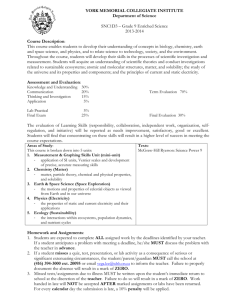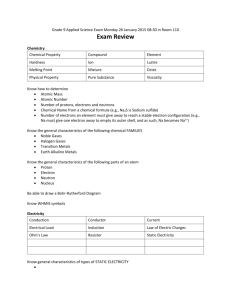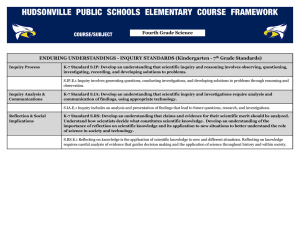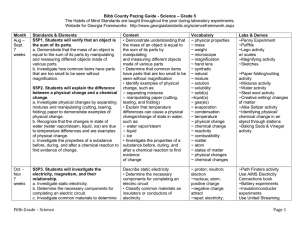4th Science Curriculum
advertisement
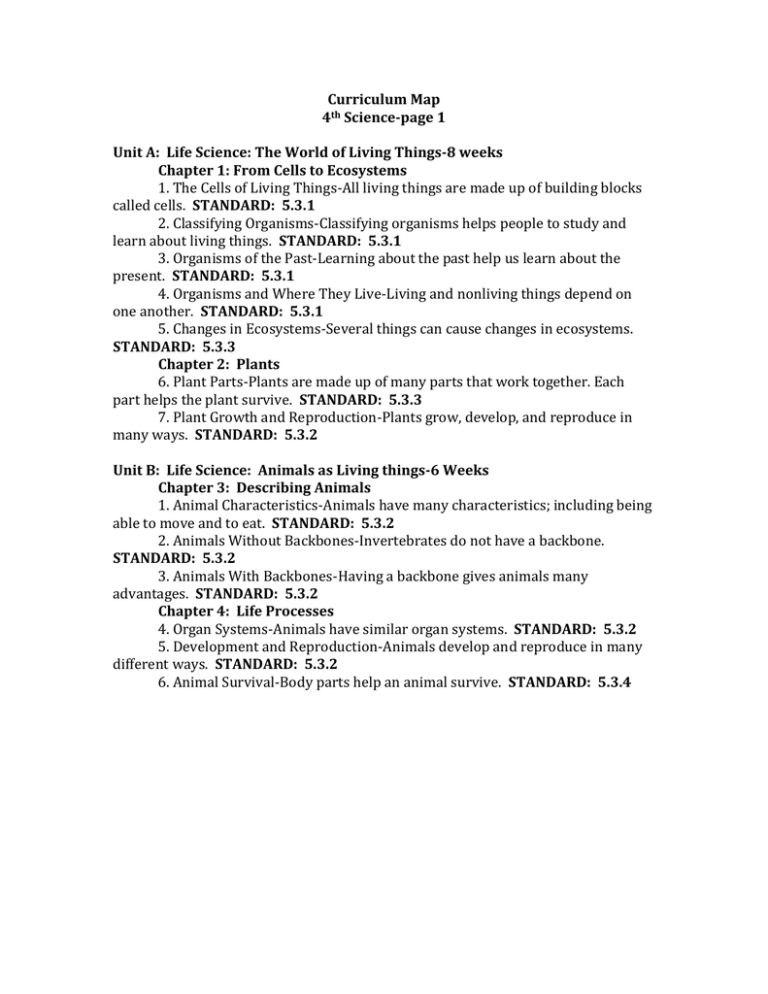
Curriculum Map 4th Science-page 1 Unit A: Life Science: The World of Living Things-8 weeks Chapter 1: From Cells to Ecosystems 1. The Cells of Living Things-All living things are made up of building blocks called cells. STANDARD: 5.3.1 2. Classifying Organisms-Classifying organisms helps people to study and learn about living things. STANDARD: 5.3.1 3. Organisms of the Past-Learning about the past help us learn about the present. STANDARD: 5.3.1 4. Organisms and Where They Live-Living and nonliving things depend on one another. STANDARD: 5.3.1 5. Changes in Ecosystems-Several things can cause changes in ecosystems. STANDARD: 5.3.3 Chapter 2: Plants 6. Plant Parts-Plants are made up of many parts that work together. Each part helps the plant survive. STANDARD: 5.3.3 7. Plant Growth and Reproduction-Plants grow, develop, and reproduce in many ways. STANDARD: 5.3.2 Unit B: Life Science: Animals as Living things-6 Weeks Chapter 3: Describing Animals 1. Animal Characteristics-Animals have many characteristics; including being able to move and to eat. STANDARD: 5.3.2 2. Animals Without Backbones-Invertebrates do not have a backbone. STANDARD: 5.3.2 3. Animals With Backbones-Having a backbone gives animals many advantages. STANDARD: 5.3.2 Chapter 4: Life Processes 4. Organ Systems-Animals have similar organ systems. STANDARD: 5.3.2 5. Development and Reproduction-Animals develop and reproduce in many different ways. STANDARD: 5.3.2 6. Animal Survival-Body parts help an animal survive. STANDARD: 5.3.4 Curriculum Map 4th Science-page 2 Unit C: Earth Science: Earth and Beyond-5 weeks Chapter 5: Earth’s History 1. What You Can Learn from Rocks-Rocks, which form in many ways, hold clues about Earth’s past. STANDARD: 5.4.4 2. Clues from Fossils-Fossils are clues to the past. STANDARD: 5.4.4 Chapter 6: Earth’s Surface and Interior 3. Shaping Earth’s Surface-Glaciers and other agents change Earth’s land. STANDARD: 5.4.2 4. The Story of Soil-Over time, processes in nature change bedrock into soil. STANDARD: 5.4.2 5. Inside Earth-Earthquakes tell about Earth’s interior. STANDARD: 5.4.4 Chapter 7: Sun, Moon, and Planets 6. Earth, the Moon, and the Sun-Earth moves around the Sun. The Moon moves around Earth. STANDARD: 5.4.1 7. The Solar System and Beyond-Earth is part of a system that includes the Sun, planets, and other objects. STANDARD: 5.4.1 Unit D: Earth Science: Water and Weather-6 weeks Chapter 8: Earth’s Water 1. Water, Water, Everywhere-Water can be in different forms in different places. STANDARD: 5.4.2 2. Follow the Water-Water exists in three states-solid, liquid, and gas. STANDARD: 5.4.2 3. Motions in the Oceans-The ocean moves in ways that affect the weather, the climate, the land, and you. STANDARD: 5.4.2 4. Go with the Flow-More than half of Earth’s fresh water is groundwater. STANDARD: 5.4.2 5. Water Please-Only a small part of Earth’s water is available for humans. STANDARD: 5.4.2 Chapter 9: Earth’s Weather 6. Air, Wind, and the Atmosphere-The conditions of the atmosphere create our weather. STANDARD: 5.4.3 7. Weather and Climate-Many things affect our weather and climate. STANDARD: 5.4.3 Curriculum Map 4th Science-page 3 Unit E: Physical Science: Matter-5 weeks Chapter 10: Properties of Matter 1. Matter-All substances can be described and classified by their properties. STANDARD: 5.2.1 2. Measuring Matter-Matter can be measured using standard and nonstandard units of measure. STANDARD: 5.2.1 Chapter 11: Changes in Matter 3. What Matter is Made of-Matter is made of tiny particles that can be classified, mixed, and combined. STANDARD: 5.2.1 4. Physical Changes-Physical changes are responsible for many of the things we encounter in everyday life, such as changes of state and changes in size or shape. STANDARD: 5.2.1 5. Chemical Changes-Chemical changes are responsible for many of the things we encounter in everyday life, such as the production of energy and making and breaking down compounds. STANDARD: 5.2.1 Unit F: Physical Science: Energy-6 weeks Chapter 12: Forms of Energy 1. Motion, Forces, and Energy-Objects move when they change their position, though objects tend to resist a change in motion (inertia) STANDARD: 5.2.2 2. Energy and Tools-Machines make work easier by changing the amount and the direction of the force applied. STANDARD: 5.2.2 3. Heat-Heat is the movement of energy from warmer to cooler objects, though not all objects allow heat to move through them equally well. STANDARD: 5.2.2 4. Light-Light travels in straight lines and can be refracted as it moves through a surface or reflected from a surface. STANDARD: 5.2.2 5. Sound-Properties of sound, such as pitch and loudness, can be changed by changing properties of the sound source, that is changing the rate of vibration. STANDARD: Chapter 13: Electricity and Magnetism 6. Static Electricity-A buildup of electrical charge causes static electricity. STANDARD: 5.2.3 7. Current Electricity-Current electricity flows through a closed circuit. STANDARD: 5.2.3 8. Electricity and Magnets-A moving magnet can produce current electricity. Current electricity flows from generators to your home. STANDARD: 5.2.3 This is scheduled for 36 weeks of school. I have set aside a couple of weeks for NeSa and MAPS Testing.


